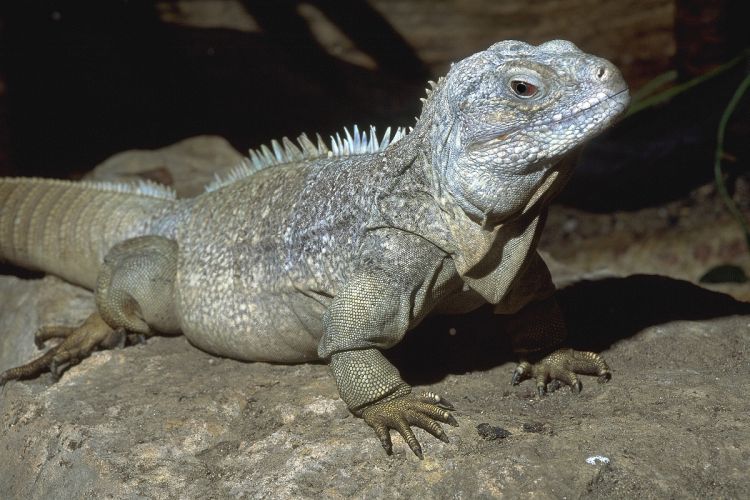Bahamas rock iguana
(Cyclura carinata)

Description
Cyclura carinata Harlan,1824 is a species of lizard of the family of iguanids endemic to the Turks and Caicos islands in the Antilles.With an adult length of 770 mm,this iguana of variable color from green to gray-brownish is one of the smallest representatives of the genus Cyclura.Presents a dorsal crest of long spines.It is an essentially herbivorous animal that feeds on leaves,flowers and fruits,which it collects on the ground or climbing on the trees.Cyclura carinata is a heterothermal animal,very active during the hot season,when it spends a few minutes to warm up in the sun before going in search of food,but much less in winter,when it stays most of the time inside its shelter without entering into a real hibernation.The males are territorial,and they defend the females with which they mate in the month of May.These lay between two and nine eggs in burrows dug by themselves in a soft substrate,not too deep.The eggs hatch 90 days later,and the young iguanas dig vertically into the ground to go out in the open air.Like that of other iguana species,the population of Cyclura carinata is in decline.It is threatened above all by predation by animals introduced on the islands like cats and dogs,despite the guaranteed protection from the legislation and the local projects of transfer of populations in areas from which it had disappeared.With an adult length of less than 770 mm,Cyclura carinata is one of the smallest species of Cyclura.The base color of the lizard can vary from green to brownish-gray,usually marked by dark patterns.The color varies during the day: it is darker in fact at night and towards sunset in full daylight.This is certainly an adaptation related to thermoregulation.Furthermore,there are considerable differences in coloration from one population to another.Iguanas also have 9 or 10 lighter bands that cross the body.These motifs are visible above all in young people,and disappear as they age.This iguana has spines that are larger than those of other iguana species.These spines lack at the level of the hips and shoulders.The 16-20 spines of the nape are clearly larger than the 45-75 spines present on the rest of the back,and can reach 2 cm.The species does not have the large scales on the upper surface of the head characteristic of other Cyclura species.The nostrils are in great part in contact with the rostrum,and the frontal,fronto-parietal and occipital regions are covered by small irregular scales with well visible edges.The scales located around the eyes are smaller than those of the rest of the head.Cyclura carinata has a heterodont dentition,typical of iguanas.The teeth are monospaced in the symphysis and up to the premaxillary,while the anterior teeth are clearly tricuspidated.This species has a well marked sexual dimorphism,even more evident than in most of the other species of the genus Cyclura.Males are larger than females (their body mass is twice as large) and have larger ridges and more pronounced femoral pores on the thighs,which are used to release pheromones aimed at attracting partners and marking the territory.
Taxonomic tree:







